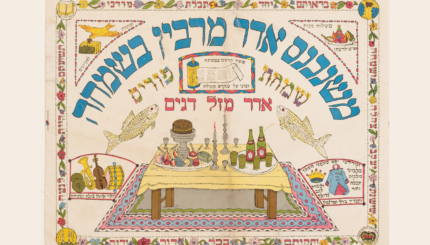celebrates the salvation of Jewry during the reign of King Ahasuerus of Persia. The mere survival of Jewry throughout history is in itself a miracle. There are several individual communities that also have their own unique stories of salvation. When faced with disaster, either from a tyrant or a natural disaster such as an earthquake or a plague, these communities miraculously escaped.
To celebrate their salvation, those communities ordained that a special Purim be celebrated. In total there might be as many as 100 such special Purims celebrated. Often families saved from certain danger also instituted their own personal “special Purims.” The message of all the Purims is the same as that of the original Purim: their deliverance was not by chance but guided by the Almighty. The following are some brief descriptions of the many special Purims.
Medieval Cairo
A poet and scholar Samuel ben Hosha’na reports that in 1323 a Muslim crowd attacked a Jewish funeral procession in old Cairo. Such attacks did occur from time to time. The Islamic Dhimmi laws prohibited the public display of Judaism or Christianity, even at funerals, and a funeral could provoke anger. Twenty-three Jews were arrested and the Jewish community locked themselves in their homes in fear as they fasted and wept.
On the third day, a group of Jews appealed to the Caliph-Al Hakim to spare the imprisoned Jews. The Caliph looked into the matter and found wrongdoing on the part of the Muslims who instigated the disturbances and had the 23 released. Out of joy, an annual feast was instituted each year to commemorate the deliverance. Hosha’na, who himself was incarcerated, composed liturgy to be recited during the feast. Hosha’na, who also composed a Megillah, or scroll, to commemorate the event, writes, “Remember this and place it before your eyes. Tell it to your children, and their children, and their children to another generation.”
With your help, My Jewish Learning can provide endless opportunities for learning, connection and discovery.
Tiberius
In the early 17th century, the city of Tiberius, which borders on Lake Kinneret in Israel’s north, was reestablished by Sheikh dair el Amar, who invited Isaac Abulafia to bring Jews to join the settlement. Soon the city had a sizable Jewish community. Governor Suleiman Pasha of Damascus laid siege to the city in 1743. For the duration of the siege, 83 days, the Jews of Tiberius helped stand in its defense. On August 27, the Pasha raised the siege, but his plans to attack Tiberius were not over. While preparing his next attack, however, he suddenly died and the Jews of Tiberius were saved from certain disaster. The Jews of Tiberius declared both the day of the lifting of the siege–the seventh day of Elul–and the day of the Pasha’s death–the fourth day of Kislev–local Purims.
Purim of Bandits
In European Turkey, near Andriapole, lies the city of Gumeldjina. In 1786, the city was attacked by bandits intent on pillaging the town. Had they been permitted to ransack the city, its Jewish community would have been in grave danger. Afterward, the Jews were accused of allowing the bandits to enter the city. Again, they were in danger. With great difficulty, however, they managed to prove their innocence. In memory of their escaping both predicaments, a special Purim was instituted on the 22nd day of Cheshvan for the Jews of Gumeldjina.
The Purim of Sharif
The city of Tripoli, which contained a large Jewish community, was threatened with extermination when the ruler of Tunis besieged the city. The leader had threatened to kill all the inhabitants of the city. With just one last fortress to conquer, a sudden epidemic spread among his soldiers and he was forced to withdraw with the remains of his army. The Jews of Tripoli instituted that day, the 24thday of Tevet, as a Purim.
Purim Sebastiano
The King Dom Sebastiano of Portugal invaded Morocco in 1578. Two Marranos [Jews who ostensibly converted to Christianity in the Inquisition but retained their religion in secret] informed the Jewish community that if the invasion succeeded, all the Jews of Morocco would be forcibly converted. At the battle of Alcazarquebir, the Portuguese were defeated and Dom Sebastiano was killed in battle. That day was set aside by the Jews of Morocco as a Purim.
Reprinted with permission of the publisher from The Jewish Holidays: A Journey Through History.(Jason Aronson, Inc.)


